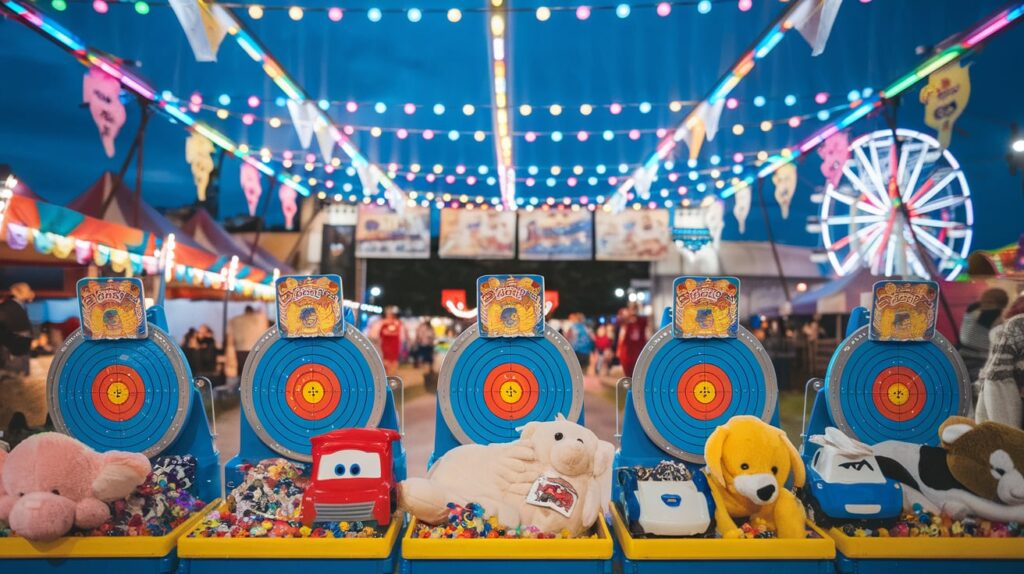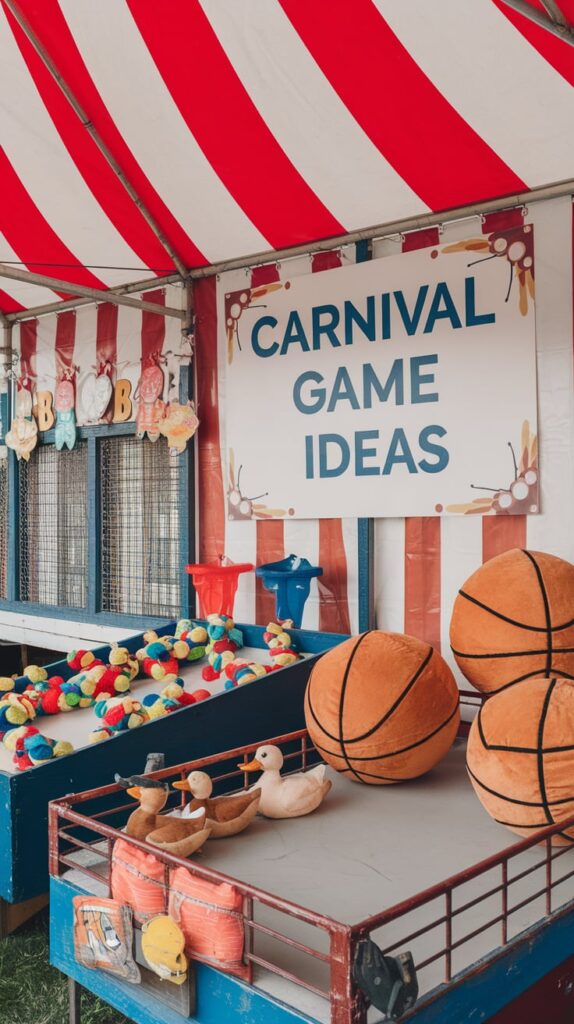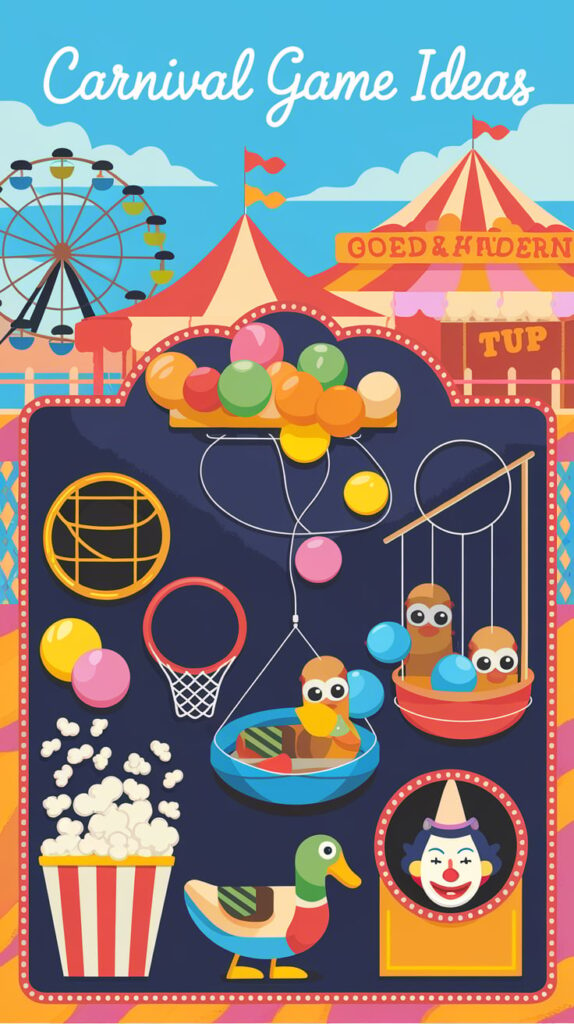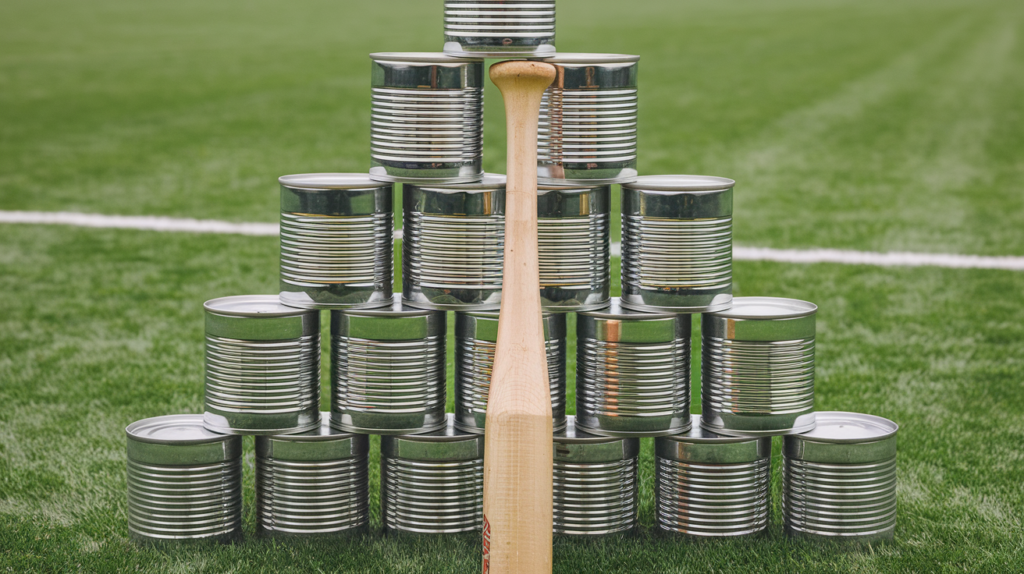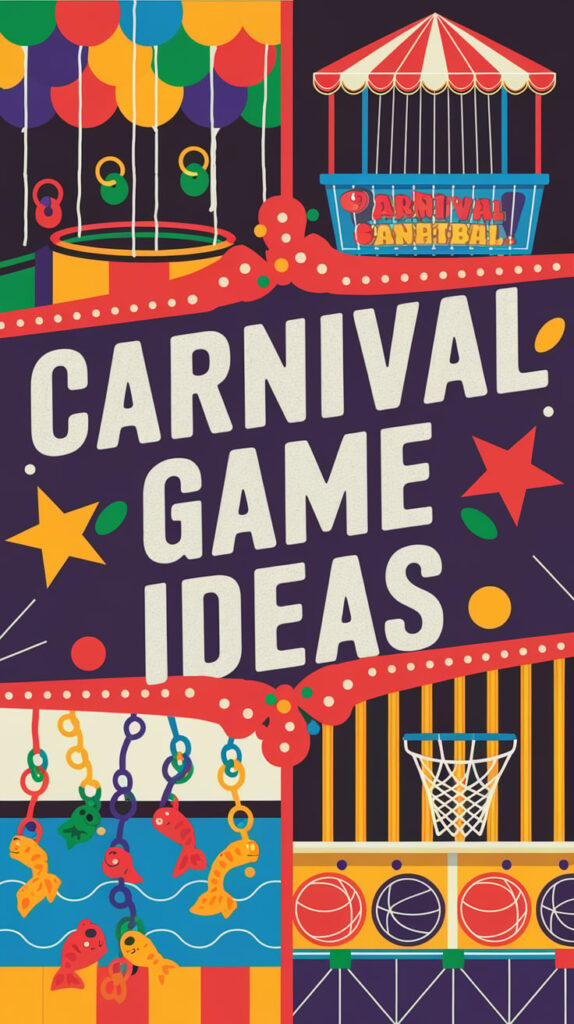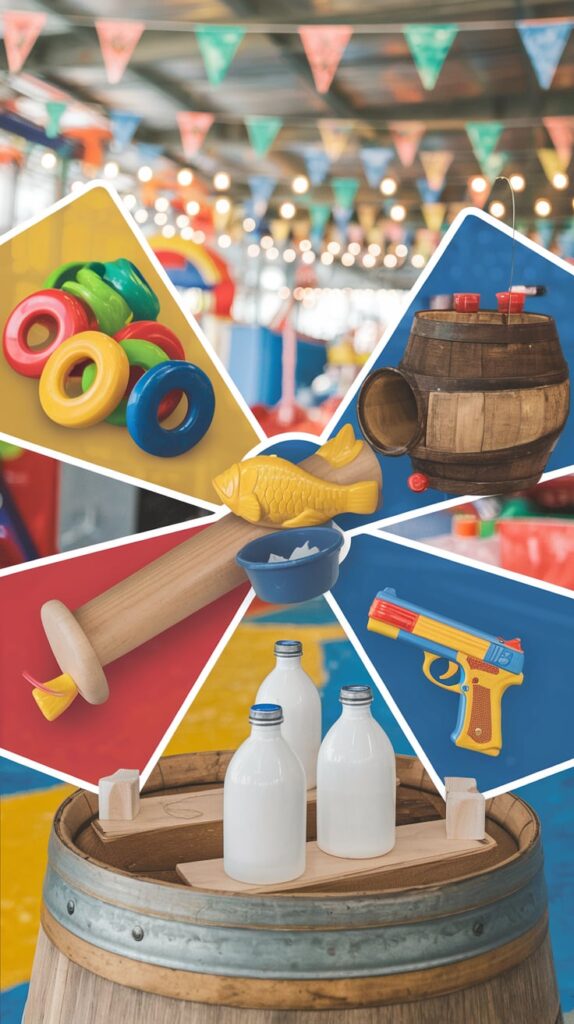Carnival game ideas bring the fun and nostalgia of a classic fair to any event, perfect for both kids and adults. Ring Toss is a staple where players try to land rings on bottles or pegs, challenging their aim and precision. Another classic is Balloon Pop, where participants throw darts to pop balloons for prizes, with each burst revealing a surprise. Duck Pond is great for younger kids, where they choose floating ducks to reveal hidden numbers or symbols that correspond to prizes.
Related Post –
- Charades Game Ideas
- Glycolysis Board Game Ideas
- Bachelorette Game Ideas
- Halloween Game Ideas
- Birthday Party Game Ideas
Bean Bag Toss or Cornhole is always a crowd favorite, where players aim to throw bean bags into holes on a board to score points. For something more unique, you could try a Spinning Wheel game, where guests spin a colorful wheel to win prizes, or a Can Knockdown, where players throw balls to knock down stacked cans for rewards. These carnival games can be easily set up at any party, bringing joyful competition and laughter to the atmosphere.
Carnival Game Ideas
Here are 10 classic carnival game names:
- Ring Toss
- Balloon Pop
- Duck Pond
- Bean Bag Toss (Cornhole)
- Can Knockdown
- Bottle Stand Game
- High Striker (Strength Tester)
- Fish Bowl Toss
- Milk Bottle Smash
- Spin the Wheel
Ring Toss
Ring Toss is a simple, fun, and competitive outdoor or indoor game where players throw rings, usually made of plastic or rope, trying to land them onto pegs or stakes. The objective is to score points by successfully “ringing” the peg. This game is popular at carnivals, fairs, or backyard gatherings, and it’s suitable for players of all ages.
How to Play Ring Toss: Step-by-Step
Step 1: Setting Up the Game
- Prepare the Pegs: Arrange one or more pegs or stakes, typically placed vertically in the ground or attached to a stand. The number of pegs may vary depending on the version of the game. For a standard setup, place 5 pegs in a cross or square arrangement.
- Position the Rings: Provide each player with a set number of rings, usually made of rope, rubber, or plastic. Each player typically gets 3-5 rings to throw per round.
Step 2: Decide the Playing Distance
- Mark a Throwing Line: Measure and mark a line from where players will toss the rings. The distance can be adjusted based on the skill level or age of the players. For kids, you may keep it close, while for adults, the line should be farther back to increase difficulty.
Step 3: Understanding the Scoring System
- Assign Points to Pegs: Some pegs may carry different point values, depending on their position. Central pegs are often worth more points, while outer pegs are worth less. The goal is to aim for the highest-scoring peg.
- Ring the Peg: A successful “ring” occurs when the ring lands around a peg or stake. If the ring simply touches or leans against a peg without circling it, it does not count.
Step 4: Throwing the Rings
- Player Turns: Players take turns throwing their rings. Stand behind the throwing line, hold a ring with one hand, and aim carefully at the pegs. Toss the ring in a smooth motion, aiming for the peg you want to score on.
- Focus on Precision: The key to success is precise throws rather than strength. Aim for a gentle, controlled throw that allows the ring to land smoothly over the peg.
Step 5: Scoring the Points
- Tally Scores: After all rings have been thrown in a round, check which pegs have been rung by each player. Each peg has its corresponding score value, and players add up their total points based on where their rings landed.
- Crowning the Winner: The player with the most points after a set number of rounds is declared the winner. You can play multiple rounds to give players more chances to score higher.
Step 6: Game Variations
- Multiple Pegs: Some variations involve multiple pegs with different point values, encouraging players to aim for specific targets.
- Time-Limited Tossing: Another variation is to play against the clock, where players must toss as many rings as possible within a limited time frame.
Step 7: Adjusting for Difficulty
- Increase the Distance: To make the game more challenging, increase the distance between the throwing line and the pegs.
- Smaller Rings or Pegs: You can also use smaller rings or pegs for a higher difficulty level, requiring more precision.
With these easy-to-follow steps, you can enjoy a competitive and entertaining game of Ring Toss, whether you’re at a carnival, picnic, or just hanging out in the backyard.
Balloon Pop
Balloon Pop is a fun and engaging game where the main objective is to pop as many balloons as possible within a set time limit or under specific rules. The game can be played in various forms—digitally as a mobile or arcade game, or physically at parties or events. It is easy to understand and suitable for players of all ages, with different variations based on skill, speed, or luck.
How to Play Balloon Pop Game: Step-by-Step Guide
Step 1: Setup the Game
- Physical Version: Inflate several balloons and scatter them across a room or tie them to strings for easy access. Each balloon can be filled with either air or water, or even surprises like small toys or prizes.
- Digital Version: Download a Balloon Pop game from an app store or play it on a computer/arcade system. The screen will display a colorful array of balloons that float around.
Step 2: Set the Rules or Timer
- For physical games, decide on the rules: Do players need to pop as many balloons as they can in a set time (e.g., 1 minute), or will they compete in rounds where the player with the most popped balloons wins?
- For digital versions, the timer is usually built-in, and the objective is to pop the balloons by tapping, clicking, or swiping them.
Step 3: Begin the Game
- Physical Version: On a signal, players begin popping balloons either by stepping on them, sitting on them, or using small pins or darts. Make sure the popping action is safe, especially for younger children.
- Digital Version: The player taps or clicks the screen to pop the balloons. Balloons may float at different speeds, and players must react quickly to pop as many as possible before they disappear.
Step 4: Track the Score
- Physical Version: For each balloon popped, players can earn points. You can also introduce different color balloons with varied point values (e.g., red balloons = 1 point, blue balloons = 3 points). Keep track of the points or the number of balloons each player pops.
- Digital Version: The game automatically counts and displays the score on the screen. Higher scores may be rewarded for popping balloons faster or in combos.
Step 5: Avoid Obstacles or Special Balloons (Optional)
- In advanced or digital versions of the game, certain balloons may contain “traps” or penalties. For example, popping a black balloon may deduct points or end the game. Players need to be cautious and avoid these to maximize their score.
- Some variations may also have “bonus balloons” that give extra points or unlock special rewards if popped within a short time.
Step 6: Game Over or Winner Announcement
- Physical Version: Once all the balloons have been popped, count each player’s total and declare the one with the highest number of pops as the winner.
- Digital Version: The game ends when time runs out, and the player’s final score is displayed. Players can either play again to beat their score or compete with friends.
Step 7: Replay and Introduce New Challenges
- To keep the game fresh, you can introduce new challenges like limiting the tools for popping balloons or increasing the speed and difficulty in digital versions. You can also increase the timer or include team-based competition to add variety.
Key Variations:
- Time-Limited Mode: Players must pop as many balloons as possible within a short period.
- Prize Balloons: Some balloons may contain hidden prizes (candy, money, or small toys) that players get when popped.
- Obstacle Mode: Some versions of the game may have “bad” balloons that players need to avoid.
Duck Pond
The Duck Pond game is a fun and simple carnival-style game that’s often played at fairs, festivals, or parties. It’s easy to set up and perfect for children, as it combines chance with a small reward system.
Here’s a step-by-step breakdown of how to play the Duck Pond game in detail:
Objective:
- The main goal is for players to select a floating duck from a pond and check its underside for a number, symbol, or color that corresponds to a prize.
Materials Needed:
- A shallow basin or pool filled with water (the “pond”).
- Plastic ducks with markings (numbers, colors, or symbols) on the bottom.
- A small net or a stick to move the ducks around the water.
- A chart or prize system that correlates with the markings on the ducks (for example, specific numbers or colors matching different prizes).
Step-by-Step Guide to Playing:
Step 1: Set Up the Pond
- Fill the basin or pool with enough water to allow the ducks to float freely. The water should be deep enough so that the ducks move easily across the surface.
- Place the plastic ducks in the water, making sure they float in such a way that the markings on the bottom are hidden from view. The ducks should be evenly spread out to make the game fair for all players.
Step 2: Explain the Game Rules
- Instruct the players that they must choose one duck from the pond. Let them know that each duck has a marking on the bottom, which determines what prize they will win.
- Make sure the players understand that they can only select one duck at a time and should not peek at the underside of any duck until they’ve officially picked it.
Step 3: Pick a Duck
- The player can use their hands or a small net to gently grab one duck from the pond. They must choose a duck without knowing which marking it carries.
Step 4: Check the Duck’s Marking
- Once the player selects a duck, they turn it over to reveal the marking on the bottom. The marking could be a number, color, or symbol. This will determine what kind of prize they win.
- For example, ducks with a red bottom might win a large prize, while ducks with a blue bottom might earn a smaller reward.
Step 5: Award the Prize
- Based on the marking on the bottom of the duck, refer to the prize chart you’ve created. Hand out the corresponding prize to the player.
- Prizes could range from small toys, stickers, or candy to larger items, depending on the marking.
Step 6: Return the Duck
- After the player receives their prize, place the duck back into the pond so that the game can continue. Ensure the markings remain hidden from the next players.
Step 7: Continue the Game
- Repeat the process for the next players. Each player gets a turn to pick one duck and win a prize based on the marking they discover.
Game Variations:
- Timed Challenge: Players must pick a duck within a certain time limit.
- Multiple Turns: Players can earn more turns by answering questions or completing tasks.
- Prize Ladder: Different markings can correspond to a tiered prize system, where certain ducks offer larger or more valuable prizes.
The Duck Pond game is a great way to engage players with a sense of mystery and excitement, as each turn holds the promise of winning something fun!
Bean Bag Toss (Cornhole)
Bean Bag Toss (Cornhole) is a popular outdoor game that’s fun for all ages and perfect for gatherings, barbecues, or tailgating events. It involves tossing small bean bags onto a raised board with a hole in it, aiming to either land on the board or sink the bag through the hole. Here’s a detailed guide to understanding and playing the game step by step:
Equipment:
- Boards: Two raised platforms, typically 2 feet wide by 4 feet long, with a 6-inch hole near the top. The boards are placed on the ground about 27 feet apart.
- Bean Bags: There are eight bean bags in total—usually made of fabric filled with dried corn kernels or synthetic beads. The bags are split into two sets of four, with each set a different color to distinguish between teams.
Objective:
- The goal is to toss your bean bags onto the opposite board or into the hole for points. The first team to reach 21 points wins.
Step-by-Step Guide to Playing Cornhole:
Step 1: Setup
- Place the two boards on flat ground, facing each other, 27 feet apart (for regulation play). The hole should be positioned at the far end of each board.
- Players divide into two teams of one or two players per side. Teammates stand on opposite boards.
Step 2: Tossing the Bean Bags
- Teams alternate throwing their bean bags, one at a time, toward the opposite board. Players must toss the bags underhand.
- The player throwing the bag must stand behind the front edge of their board (the foul line).
Step 3: Scoring
- On the board: If the bean bag lands and stays on the surface of the board, it scores 1 point.
- In the hole: If the bean bag goes through the hole, it scores 3 points.
- No points: If the bag bounces off the ground before landing on the board, it doesn’t count and should be removed from the board.
Step 4: Cancelling Points
- Cornhole uses a “cancellation” scoring system. After both teams have thrown all four of their bags, the scores from that round are calculated and the lower score is subtracted from the higher score.
- For example, if Team A scores 5 points and Team B scores 3 points in a round, Team A earns 2 points (5 – 3 = 2).
Step 5: Alternating Rounds
- Once a round is complete, the teams switch throwing sides (players walk to the opposite board). The team with the higher score from the previous round tosses first.
Step 6: Winning the Game
- The game continues with alternating rounds until one team reaches or exceeds 21 points.
- If a team scores exactly 21 points at the end of a round, they win. However, if they exceed 21, some versions of the game state that the team’s score resets to 15 points (this rule varies by house rules).
Strategic Tips:
- Aim for the hole: Scoring 3 points by getting the bag into the hole can help win faster.
- Block and knock: You can block your opponent’s bags by strategically placing yours on the board or knock off their bags with a well-placed toss.
- Arc the throw: Throwing the bean bag with an arc gives it a soft landing, increasing the chance of it staying on the board.
Can Knockdown
Can Knockdown is a classic carnival-style game that tests your aim and precision by challenging you to knock over stacked cans using a ball. The goal is to topple all the cans with as few throws as possible.
Here’s a detailed step-by-step guide on how to play this fun and exciting game:
Step 1: Set Up the Cans
- Begin by arranging a pyramid of empty cans. Typically, you’ll stack the cans in three levels:
- The base consists of three or more cans.
- The middle level has two cans.
- The top level has one can.
- The cans should be placed on a flat, stable surface like a table or platform.
Step 2: Choose Your Ball
- Select a lightweight ball, usually made of rubber or soft material. The ball should be easy to hold and throw accurately. Some versions of the game use beanbags instead of balls.
Step 3: Establish the Throwing Line
- Mark a line on the ground from which players will throw. The distance between the throwing line and the cans should be adjusted based on the difficulty level. For beginners, keep the distance shorter; for more advanced players, increase it.
Step 4: Position Yourself
- Stand behind the throwing line and get into a comfortable stance. Keep your feet steady and make sure you have a clear view of the stacked cans. Holding the ball in your dominant hand, focus on your target.
Step 5: Aim for the Base
- When throwing the ball, aim for the base cans. Hitting the bottom cans usually causes the entire pyramid to collapse. You can also aim at the middle if you’re going for a more strategic shot.
Step 6: Throw the Ball
- Throw the ball with controlled force. Use a smooth motion to ensure accuracy. It’s important to avoid throwing too hard, as the ball might miss the cans entirely. A well-aimed shot with medium strength usually works best.
Step 7: Knock Down All the Cans
- Your objective is to knock down every can. Players usually have a limited number of throws, often three, to clear the entire pyramid. After each throw, check how many cans are still standing.
Step 8: Reset and Repeat
- After each round, reset the cans by stacking them in the pyramid formation again. You can increase the challenge by varying the height of the stack or changing the number of throws allowed.
Winning the Game
- The game can be played individually or in groups. If played with friends, each player takes turns throwing, and the winner is the one who knocks down the most cans in the fewest throws. If you knock all the cans down in a single throw, you score bonus points or win automatically, depending on the rules you set.
Bottle Stand Game
The Bottle Stand Game is a simple yet fun activity that challenges players’ balance, precision, and patience. The objective of the game is to stand a bottle upright using only a string attached to a ring or hook. Here’s how you can play the game, explained step by step:
Materials Needed:
- A bottle (plastic or glass) with a flat base
- A string (approximately 2-3 feet long)
- A small ring, loop, or hook tied to one end of the string
- A flat surface to play on
Step-by-Step Instructions:
Step 1: Set Up the Bottle
- Place the bottle in the center of a flat surface like a table or floor. The bottle should be upright and stable to begin with. This is the object players will attempt to stand up using the string.
Step 2: Attach the String to the Hook
- On one end of the string, tie a small ring or hook securely. This will serve as the tool to catch the bottle neck and help guide the bottle to stand upright. Ensure the ring fits loosely around the neck of the bottle without much friction.
Step 3: Position Yourself
- Hold the other end of the string, keeping the ring or hook on the surface near the base of the bottle. The idea is to manipulate the string and guide the bottle into a standing position by pulling it gently upright.
Step 4: Hook the Bottle
- Place the ring or hook over the neck of the bottle. Ensure the string is slightly taut, but not so tight that it pulls the bottle off balance too early. The key is to maintain control and balance the bottle slowly.
Step 5: Gently Pull the String
- Start pulling the string slowly while keeping the hook or ring securely around the bottle neck. As you pull the string, lift it at a gentle angle to bring the bottle into an upright position. This requires steady hands and patience.
Step 6: Achieve Balance
- As the bottle starts to tilt upward, adjust the tension on the string to keep it from toppling over. You need to maintain a delicate balance, using the string as a guide to control the bottle’s movement.
Step 7: Stand the Bottle
- Once the bottle is nearly upright, carefully release the tension on the string, allowing the bottle to stand on its own. The challenge is to do this without causing the bottle to fall or lose balance.
Step 8: Celebrate Success or Try Again
- If the bottle stands successfully, you’ve won the game! If the bottle tips over or doesn’t stand up, reset it and try again. Practice makes perfect!
Game Variations:
- Time Challenge: Players compete to see who can stand the bottle the fastest.
- Distance Challenge: Increase the difficulty by starting farther away from the bottle.
- Team Play: Players can work together or compete in turns to achieve the fastest or most precise bottle stand.
Key Skills:
- Coordination: The game tests how well you can control your movements.
- Patience: Rushing will likely cause the bottle to topple, so steady hands are crucial.
- Focus: Concentration is key to maintaining the right balance between pulling and releasing the string.
High Striker (Strength Tester)
The High Striker, often referred to as the “Strength Tester” game, is a classic carnival and fair attraction where players test their physical strength by striking a lever with a mallet to send a weight flying up a vertical tower toward a bell. The goal is to hit the bell at the top, proving your strength. Here’s how to play this game, step-by-step, with unique instructions:
Step 1: Approach the High Striker
- The High Striker consists of a tall vertical tower with a bell at the top, a lever at the base, and a puck or weight that shoots upward when struck. A large mallet or hammer is used to hit the lever. Begin by standing in front of the lever and examining the equipment.
Step 2: Select the Mallet
- Pick up the mallet, typically a heavy rubber or wooden tool with a large head. The mallet’s size varies, so choose one that feels comfortable and manageable for you to lift and swing with both hands.
Step 3: Position Yourself
- Stand with your feet shoulder-width apart, ensuring you have a stable base for your strike. You’ll want to be about an arm’s length away from the lever, so you can swing the mallet in a full arc.
Step 4: Grip the Mallet
- Hold the mallet with both hands, gripping the handle tightly. One hand should be near the bottom of the handle for control, and the other toward the middle for power.
Step 5: Wind Up
- Lift the mallet high above your head, bending your elbows slightly to prepare for the swing. Keep your eyes focused on the target—the lever at the base of the High Striker.
Step 6: Swing with Force
- In one smooth, powerful motion, swing the mallet downward with all your strength. Aim to hit the center of the lever directly. Your goal is to generate enough force to push the lever down and send the puck flying up the tower.
Step 7: Watch the Result
- After striking, watch as the puck travels up the tower. The force you applied determines how high it goes. If it reaches the top, the bell will ring, signaling that you’ve won or reached the “strong” level.
Step 8: Try Again (Optional)
- If the puck didn’t reach the bell, you can try again. Adjust your stance or swing technique to generate more power, or swing with more speed and follow-through to increase your chances.
Tips for Playing:
- Use your legs to add power to your swing—bend slightly at the knees and use your whole body to drive the mallet downward.
- Make sure you hit the lever dead center for the most efficient energy transfer.
- Don’t rush the swing; a controlled and powerful swing is more effective than just hitting wildly.
Fish Bowl Toss
The Fish Bowl Toss is a popular carnival game that tests aim and hand-eye coordination. The goal is to toss small balls into a series of fish bowls, each typically filled with water. The game is both fun and challenging, and prizes are usually awarded based on the number of successful tosses.
Step-by-Step Guide on How to Play the Fish Bowl Toss Game:
Step 1: Setting Up the Game
- Arrangement of Bowls: Multiple fish bowls are arranged in a grid or cluster on a table, often at different distances from the players. The bowls may be placed close together, making it seem easier but adding difficulty due to their small size.
- Filling the Bowls: Each fish bowl is usually filled with water to give the balls a little bounce and prevent them from just dropping straight in.
- Ball Selection: Players are given a set of small, lightweight plastic or ping-pong balls for tossing.
Step 2: Understand the Goal
- Objective: The aim is to land as many balls as possible inside the fish bowls. Depending on the rules of the carnival, each ball that lands in a bowl may earn points, or certain bowls may be designated for bigger prizes.
- Prizes: The prize can vary, from small toys to stuffed animals or even live goldfish in some cases. The prize level typically depends on how many balls you successfully toss into the bowls.
Step 3: Prepare Your Throw
- Focus on Your Target: Before tossing, choose a specific bowl to aim for. Randomly tossing balls can make it harder to land a successful throw, so focus and aim at one bowl at a time.
- Adjust Your Distance: Stand at the designated starting line. The distance to the fish bowls may vary, but players must not cross this line during their toss.
Step 4: Execute the Toss
- Toss Technique: Hold the ball gently between your thumb and fingers. Aim slightly above the bowl you’re targeting, keeping in mind that the ball may bounce off the water or rim. The toss should be smooth and gentle to avoid overshooting or bouncing the ball out of the bowl.
- Practice the Arc: Since fish bowls are small, you’ll need to toss the ball in an arc, not directly. A high arc increases the chances of the ball softly landing in the bowl without bouncing out.
Step 5: Deal with Challenges
- Bounce Factor: Be prepared for the ball to bounce, especially off the water’s surface. A gentle toss minimizes the bounce, so aim to have the ball land softly in the bowl.
- Crowded Bowl Placement: Bowls are usually placed close together, making it difficult to land the ball cleanly in one. Try to aim at bowls that have more space around them.
Step 6: Scoring and Winning
- Count Successful Tosses: Each time a ball lands and stays inside a bowl, it’s a successful toss. Some versions of the game may have specific colored bowls that yield higher points or bigger prizes.
- Prize Selection: Based on the number of successful tosses, players can select their prize. More successful tosses typically lead to better rewards.
Tips for Success:
- Patience is Key: Don’t rush your throws. Taking your time to aim will increase your accuracy.
- Learn from Each Toss: If you miss a bowl, adjust your next throw based on how the ball reacted. Too hard? Throw softer. Too short? Use more force.
- Use the Arc: Mastering the high, soft arc is crucial. Practice keeping a consistent arc with each toss.
Milk Bottle Smash
The Milk Bottle Smash game is a classic carnival or amusement park game that tests your aim and throwing accuracy. The goal is simple: knock down a stack of lightweight, hollow milk bottles using a ball, typically made of soft material like rubber or foam. The game is designed to appear easy, but it requires precision and strategy to win. Players often find the bottles are harder to topple than they look, as they’re sometimes weighted or stacked in a challenging way.
How to Play Milk Bottle Smash – Step-by-Step Guide:
Step 1: Approach the Game Booth
- Find a milk bottle smash game booth at a carnival or fair. You’ll see a display of bottles stacked in a pyramid or another formation, usually on a small platform. Typically, the base of the pyramid is made up of three to six bottles, with a few bottles stacked above them.
Step 2: Receive the Balls
- The game attendant will provide you with a set number of balls to throw, usually 2 or 3, depending on the rules of the booth. The balls are typically medium-sized and have enough weight to knock down the bottles but are soft enough for safety.
Step 3: Analyze the Stack of Bottles
- Before you start throwing, take a moment to observe how the bottles are stacked. Look for the base bottles that are supporting the entire formation. Knocking these bottles down first can give you the best chance of collapsing the entire structure.
Step 4: Take Your Position
- Stand behind the designated throwing line, which is usually marked on the ground. Make sure you are a comfortable distance from the bottles to give yourself enough room to throw with control and power.
Step 5: Aim for the Base Bottles
- When you throw, aim at the lower row of bottles. Hitting the base bottles will destabilize the entire pyramid, increasing your chances of knocking down all of them. Avoid aiming too high, as the top bottles alone won’t cause the entire stack to fall.
Step 6: Use a Strong but Controlled Throw
- When throwing the ball, use enough force to knock over the bottles but maintain control over your aim. A wild throw could miss the target or bounce off without doing much damage. If your first throw doesn’t knock down all the bottles, adjust your aim and power for the next one.
Step 7: Repeat with Remaining Balls
- Use your remaining balls to try and knock down any leftover bottles. If the stack is already destabilized after your first throw, the remaining bottles may be easier to hit.
Step 8: Win a Prize (If Successful)
- If you successfully knock down all the bottles within the given number of throws, you win a prize! Prizes can range from small stuffed animals to larger items depending on the difficulty of the game and the size of the fair.
Strategy Tips:
- Aim for the Center: Always target the middle of the base to hit the most bottles with one throw.
- Stay Focused: Take your time and aim carefully; rushing your throw can lead to inaccuracy.
- Throw with Enough Force: Light throws often bounce off, while a controlled, firm throw has better results.
Spin the Wheel
The Spin the Wheel game is a fun, chance-based activity where players spin a large, colorful wheel divided into segments to win prizes or achieve a goal. Each segment typically has different rewards or outcomes, and players rely on luck to determine which segment the pointer stops at after the wheel spins. This game can be adapted for a variety of settings, from parties to game shows, or even as an online game.
How to Play Spin the Wheel: Step-by-Step Guide
Step 1: Set Up the Wheel
- Physical Version: If using a physical wheel, set it up securely on a flat surface or stand. Ensure the wheel is divided into multiple sections, each labeled with a unique prize, task, or outcome. The sections can be evenly distributed, and each should have a corresponding color or label.
- Digital Version: For an online or virtual version, use a digital wheel generator. Input the different prizes or outcomes into each segment on the app or website.
Step 2: Explain the Rules
- Before beginning, explain the rules of the game. Typically, each player gets one spin per turn. Inform players of what each segment of the wheel represents—whether it’s prizes, tasks, or any other outcomes.
- Clarify if there are any special rules, such as bonus spins for landing on certain sections or penalties for others.
Step 3: Spin the Wheel
- Physical Spin: The player takes hold of the wheel and spins it by pulling or pushing the wheel with their hand. Encourage the player to give it a strong, even spin so that it rotates multiple times before stopping.
- Digital Spin: In an online game, the player clicks a button or taps a designated area to initiate the virtual spin. The wheel will then spin automatically for a few seconds before slowing down and stopping on a specific section.
Step 4: Wait for the Wheel to Stop
- After the wheel is spun, everyone watches as it slows down. The pointer or indicator at the top of the wheel will determine which section it stops on. The anticipation builds as the wheel gradually halts.
Step 5: Determine the Outcome
- Once the wheel stops, the segment directly under the pointer is the player’s result. This could be a prize, a task, a penalty, or any other predetermined outcome. Announce the result clearly so that everyone is aware of the player’s fate.
Step 6: Claim Prize or Complete Task
- Based on where the wheel landed, the player either claims their prize or completes the task or challenge associated with that segment. If it’s a prize, they collect it; if it’s a task, they perform it immediately.
- In some variations, players may get a chance for additional spins or re-spins based on their result.
Step 7: Continue Play
- The game continues as the next player takes their turn to spin the wheel. Each player gets a chance to spin the wheel and receive their outcome. The game may continue until everyone has had a turn, or you can set a specific number of rounds for each player.
Step 8: End of the Game
- The game concludes once all players have had their spins or when a special condition is met (e.g., a grand prize has been won). Optionally, the player with the best outcome or highest value prize could be declared the overall winner.
Additional Variations
- Challenge Mode: Instead of prizes, some sections may require players to complete challenges or answer trivia questions.
- Elimination: Players who land on certain sections may be eliminated from the game until only one remains.
- Bonus Spin: Some wheels have special sections that grant players an extra spin or double the prize.
Spin the Wheel is a simple yet exciting game where luck is the key factor. The randomness keeps players engaged, and the customizable nature of the wheel makes it adaptable for different occasions!

Hi, I’m Maggie Culp, the founder of PartyVibesFun.com, based in North Little Rock, Arkansas, United States! With a passion for creating unforgettable celebrations, I specialize in turning any event into a fun and vibrant experience. From birthday parties to themed gatherings, I’m here to help you bring your party ideas to life with ease and excitement. Whether you’re looking for unique games, creative themes, or party planning tips, I’m dedicated to making sure every moment of your event is filled with joy. Let’s create memories together and make your next party the talk of the town!



